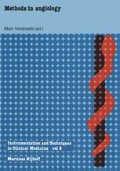Abstract
The force of cardiac contraction is transmitted to the arterial system as pressure which maintains patency of blood vessels and perfusion of capillaries. The term pressure is derived from the Latin verb, premere, meaning to act on with steady force or weight. It is defined as the static force per unit area exerted by a column of fluid according to the equation: P = h × d × a, where h and d are the height and density of the column of fluid and a is the acceleration of gravity. In physics or engineering, the units of pressure are expressed in absolute units of the cgs (centimetergram-second) system as cm × g/cm3 × cm/sec2. This expression reduces to g/sec2-cm or g-cm/sec2-cm2 or dynes/cm2, where the dyne is the unit of force. However, for biological systems, these units are simplified to the height in millimeters of a standard reference fluid, mercury by convention, with the density of mercury, d, and the acceleration of gravity, a, omitted since they are constants. In physiology, the units of pressure are then expressed as mm Hg. Mercury is used as a standard fluid because of its high density, thereby permitting measurement of arterial pressure with a relatively short tube. The relation between mm Hg and cgs units can be calculated as follows: 1 mm Hg = (0.1 cm) (13.6 g/cm3) (980 cm/sec2) where 0.1 cm is 1 mm height of the column, 13.6 g/cm3 is the density of mercury, and 980 cm/sec2 is the acceleration due to gravity.
Access this chapter
Tax calculation will be finalised at checkout
Purchases are for personal use only
Preview
Unable to display preview. Download preview PDF.
References to Main Text
Hansen AT, Warburg E: The theory for elastic liquid containing membrane manometers. Acta physiol. scand. 19: 306–349, 1950.
Fry DL: Physiologic recording by modern instruments with particular reference to pressure recording. Physiol. Rev. 40: 753–788, 1960.
Attlinger EO, Anne A, McDonald DA: Use of Fourier series for the analysis of biological systems. Biophys. J. 291–304, 1966.
Yanof HM, Rosen AL, McDonald NM, McDonald DA: A critical study of the response of manometers to forced oscillations. Phys. med. Biol. 8: 407–422, 1963.
Yanof HM: Biomedical Electronics, Davis, 1965, p 265–284.
Fry DL, Noble FW, Mallos AJ: An evaluation of modern pressure recording systems. Circulat. Res. 5: 40–46, 1957.
Gleason WL, Braunwald E: Studies on the first derivative of the ventricular pressure pulse in man. J. clin. Invest. 41: 80–91, 1962.
Wallace AG, Skinner NS, Mitchell HJ: Hemodynamic determinants of the maximal rate of rise of the left ventricular pressure. Amer. J. Physiol. 205: 30–36, 1963.
Patel DJ, Mason DT, Ross J, Braunwald E: Harmonic analysis of pressure pulses obtained from the heart and great vessels of man. Amer. Heart J. 69: 785–794, 1965.
Knopp TJ, Rahimtoola SH, Swan HJC: The first derivative of ventricular pressure recorded by means of conventional cardiac catheter. Cardiovasc. Res. 4: 398–404, 1970.
Gersh BJ, Hahn CEW, Prys-Roberts C: Physical criteria for measurement of left ventricular pressure and its first derivative. Cardiovasc. Res. 5: 32–40, 1971.
Gould KL, Trenholme S, Kennedy JW: In vivo comparison of catheter manometer systems with the catheter tip micromanometer. J. appl. Physiol. 34: 263–267, 1973.
Cronvich JA, Burch GE, Frequency characteristics of some pressure transducer systems. Amer. Heart J. 77: 792–797, 1969.
Shapiro GG, Krovetz LJ: Damped and undamped frequency responses of underdamped catheter manometer systems. Amer. Heart J. 80: 226–236, 1970.
Scruggs V, Pietras RJ, Rosen KM: Frequency response of fluid filled catheter micro-manometer systems used for measurement of left ventricular pressure. Amer. Heart J. 89: 619–624, 1975.
Falsetti HL, Mates RE, Carroll RJ, Gupta RL, Bell AC: Analysis and correction of pressure wave distortion in fluid filled catheter systems. Circulation 44: 165–172. 1974.
Futamura Y: Correction of distortions of pressure waves obtained with catheter-manometer systems. Jap. Heart J. 18: 664–678, 1977.
Brower RW, Spaans W, Rewiersma PAM, Meester GT: A fully automatic device for compensating for artifacts in conventional catheter-manometer pressure recordings. Biomed. Eng. 10: 305–310, 1975.
Rowell LB, Brengelmann GL, Blackmon JR, Bruce RA, Murray JA: Disparities between arotic and peripheral pulse pressures induced by upright exercise and vasomotor changes in man. Circulation 32: 954–964, 1968.
Krovetz U, Jennings RB, Golgbloom SD: Limitation of correction of frequency dependent artefact in pressure recordings using harmonic analysis. Circulation 50: 992–997, 1974.
Li JKJ, van Brummelen AGW, Noordergraaf A: Fluid filled pressure measurement systems. J. appl. Physiol. 40: 839–843, 1976.
Lapointe AC, Roberge FA: Mechanical damping of the manometric system used in the pressure gradient technique. IEEE Trans. Biomed. Eng. 21: 76–78, 1974.
Dear HD, Spear AF: Accurate method for measuring dp/dt with cardiac catheters and external transducers. J. appl. Physiol. 30: 897–899, 1971.
Editor information
Editors and Affiliations
Rights and permissions
Copyright information
© 1980 Martinus Nijhoff Publishers bv, The Hague
About this chapter
Cite this chapter
Gould, K.L. (1980). Intra-arterial pressure. In: Verstraete, M. (eds) Methods in Angiology. Instrumentation and Techniques in Clinical Medicine, vol 2. Springer, Dordrecht. https://doi.org/10.1007/978-94-009-8878-1_8
Download citation
DOI: https://doi.org/10.1007/978-94-009-8878-1_8
Publisher Name: Springer, Dordrecht
Print ISBN: 978-94-009-8880-4
Online ISBN: 978-94-009-8878-1
eBook Packages: Springer Book Archive

